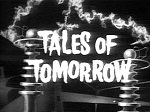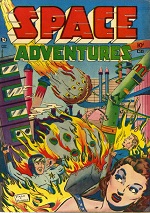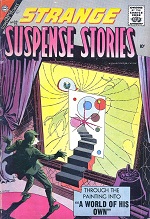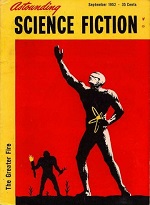|  | | | | 

| | Tales of Tomorrow
aka Tomorrow Is Yours
by Theodore Sturgeon and Mort Abrahamson
First time travel: 8 Feb 1952

When Sturgeon and Abrahamson sold the idea of this anthology show to ABC, they had the backing of the Science Fiction League of America, giving ABC first shot at any stories written by league members. They took good advantage of the deal, including stories by Fredric Brown, Arthur C. Clarke, C.M. Kornbluth, and others including Henry Kutter and C.M. Moore’s “What You Need”. That excellent 1945 story involves future prediction without time travel, but I included it in my time-travel list just because I liked it so much (and it was later made into a Twilight Zone episode, too). Hence, I’ll count the Feb 1952 airing of the story as the first time travel in Tales of Tomorrow. There were at least four other see-into-the-future-or-past episodes, but I won’t include them in the list below. After all, one must have standards!

In general, I’d place the stories on the more horrific end of the science fiction scale, but certainly worth watching.- What You Need (8 Feb 1952) Henry Kuttner and C.M. Moore
- The Little Black Bag (30 May 1952) C.M. Kornbluth
- Ahead of His Time (18 Jul 1952) Paul Tripp
- The Chase (19 Sep 1952) Mann Rubin
- Another Chance (13 Feb 1953) Frank De Felitta
- Past Tense, with Boris Karloff (3 Apr 1953) Robert F. Lewine
 After my treatment, you’l awake. You’ll find yourself in a room a thousand miles from here and back seven years in time. You’ll have absolutely no remembrance of these past seven years. The slate will be clean. After my treatment, you’l awake. You’ll find yourself in a room a thousand miles from here and back seven years in time. You’ll have absolutely no remembrance of these past seven years. The slate will be clean. 

—“Another Chance”
| |
| | | | |

 
 
 
 | | | | 



| | Charlton Comics (Anthologies)
First time travel: Space Adventures 1, Jul 1952

 Charlton’s first issue of Space Adventures included a character called Hap Holliday, the Time Skipper, who travels to the future to rescue a queen. Hap appeared again in issue 3. Charlton’s first issue of Space Adventures included a character called Hap Holliday, the Time Skipper, who travels to the future to rescue a queen. Hap appeared again in issue 3.

Later in the 1950s, with the legal demise of Fawcett Comics in the ’50s, Charton Comics took over the non-superhero Fawcett titles, and I’m still tracking down their time-travel stories, but the earliest I’ve found so far is a Steve Ditko tale, “The Last Laugh” in Strange Suspense Stories 32 (May 1957). As I find more definitive time-traveling (surely there’s some in the comic book version of The Mysterious Traveler), I’ll include the comics on my time-travel comics page. What a book title! Time—The Fourth Dimension! Going time travelling, Lester? What a book title! Time—The Fourth Dimension! Going time travelling, Lester? 

—from “The Last Laugh”
| |
| | | | |

 
 
 
 
 | | | |  | | “The Entrepreneur”
by Thomas Wilson
First publication: Astounding, Sep 1952

Ivan Smithov, an upstanding U.S. Communist from the year 2125, is charged with making arrangements for a team of three entrepreneurs to visit the U.S. in 1953 to make preparations for a time tourist enterprise—but Ivan runs into problems procuring local currency for the expedition from the Soviet embassy of the time until his companions’ behavior draws enough attention that the ambassador begins to believe him. But what other consequences might their goings-on have? Mrat-See turned quickly, wincing at the protest of his aching muscles. The creature standing before him might have issued from a nightmare. Its heavy, barrellike body was slung like a hammock on four bowed legs. The enormous head, with undershot jaw, protruding fangs, and pendulous lips, was turned toward him unswervingly, and the continuing growl was a deep rumble of menace from the massive chest. Mrat-See’s heart leaped with fear. He had seen such creatures before in the Yorkgrad zoo. Dogs they were called. Mrat-See turned quickly, wincing at the protest of his aching muscles. The creature standing before him might have issued from a nightmare. Its heavy, barrellike body was slung like a hammock on four bowed legs. The enormous head, with undershot jaw, protruding fangs, and pendulous lips, was turned toward him unswervingly, and the continuing growl was a deep rumble of menace from the massive chest. Mrat-See’s heart leaped with fear. He had seen such creatures before in the Yorkgrad zoo. Dogs they were called. 
| |
| | | | |

 
 
No Time Travel. Move along. |
“The Island of Five Colors” by Martin Gardner [4D spacial topology ]

“Catch That Martian” by Damon Knight, Galaxy, Mar 1952 [nearby tenuous universes ]

“What If—” by Isaac Asimov, Fantastic, Summer 1952 [viewing alternate pasts ]

“All the Time in the World” by Arthur C. Clarke, Startling Stories, Jul 1952 [personal time rate differences ]

“Sail On! Sail On!” by Philip José Farmer, Startling Stories, Dec 1952 [alternate history ]

| |     |